ВУЗ: Казахская Национальная Академия Искусств им. Т. Жургенова
Категория: Книга
Дисциплина: Не указана
Добавлен: 03.02.2019
Просмотров: 21606
Скачиваний: 19
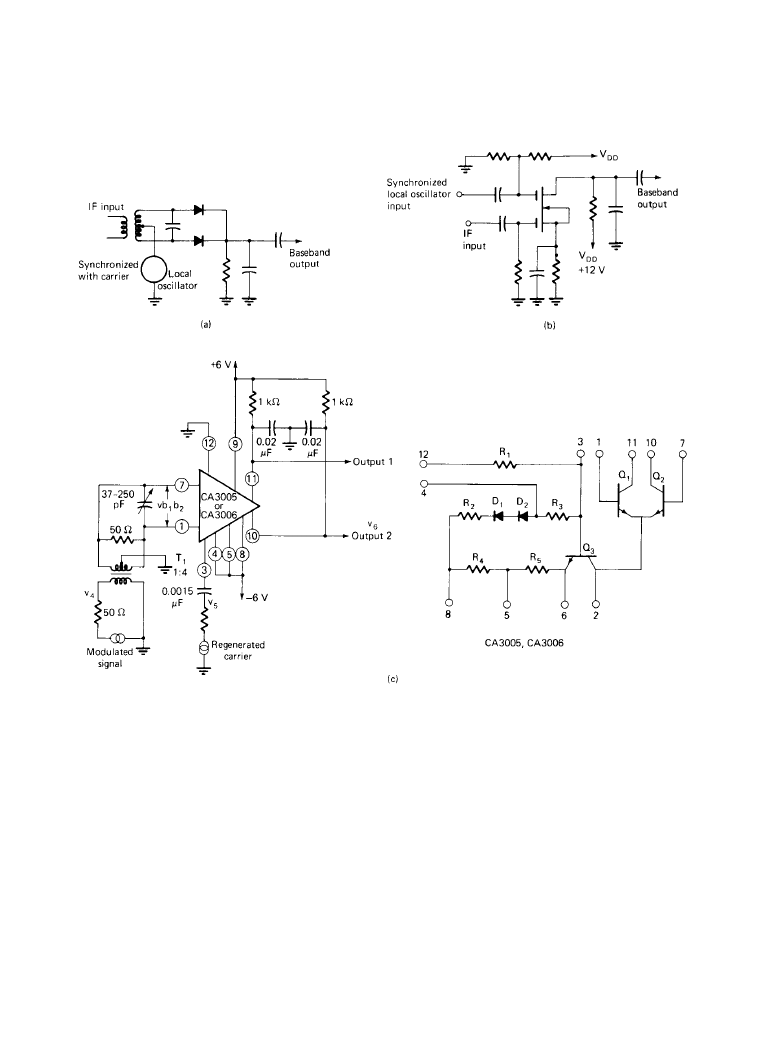
AM and FM Receivers 12-63
the demodulated output is increased from the average of a half a sine wave (0.637 peak) to the
full peak, and the RF components are substantially reduced. A peak rectifier used in this way is
often referred to as an envelope detector or demodulator. It is the circuit most frequently used for
demodulating AM broadcast signals.
AM signals may also be demodulated by using a coherent or synchronous demodulator. This
type of demodulator uses a mixer circuit, with an LO signal synchronized in frequency and phase
to the carrier of the AM input. Figure 12.3.22 illustrates three approaches to synchronous
demodulation. The synchronous component can be generated by an oscillator phase-locked to
the carrier, as illustrated in Figure 12.3.23.
Figure 12.3.22
Three types of synchronous demodulators: (
a) diode-based circuit, (b) dual-gate
MOSFET-based circuit, (
c) bipolar IC (CA3005/CA3006) basic circuit.
Downloaded from Digital Engineering Library @ McGraw-Hill (www.digitalengineeringlibrary.com)
Copyright © 2004 The McGraw-Hill Companies. All rights reserved.
Any use is subject to the Terms of Use as given at the website.
AM and FM Receivers
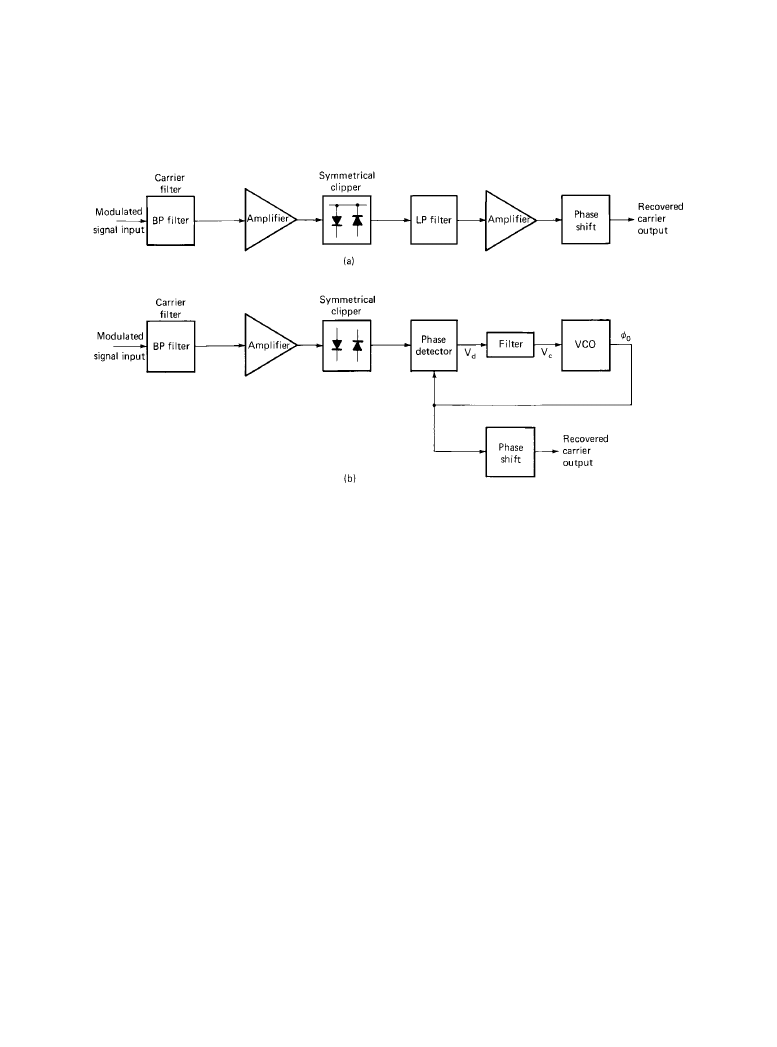
12-64 Radio Receivers
The synchronous demodulator translates the carrier and sidebands to baseband. As long as
the LO is locked to the carrier phase, baseband noise results only from the in-phase component
of the noise input. Consequently the noise increase and S/N reduction that occur at low levels in
the envelope demodulator are absent in the synchronous demodulator. The recovered carrier fil-
tering is narrow band, so that phase lock can be maintained at carrier-to-noise levels below useful
modulation output levels. This type of circuit, while better than an envelope demodulator, is not
generally used for AM broadcast demodulation because of its complexity. Most stereo AM
receivers, however, incorporate synchronous demodulators as part of the decoding circuit.
FM Demodulation
The most common technique for FM demodulation incorporates the use of linear circuits to con-
vert frequency variations to envelope variations, followed by an envelope detector. Another tech-
nique used with linear integrated circuits involves the conversion of frequency variations to
phase variations that are then applied to a phase demodulator. Still other FM demodulators
employ PLLs and frequency-locked loops (FM feedback circuits), or counter circuits whose out-
put is proportional to the rate of zero crossings of the wave. Frequency demodulators are often
referred to as discriminators or frequency detectors.
Resonant circuits are used in discriminators to provide adequate sensitivity to small-percent-
age frequency changes. To eliminate the dc components, two circuits can be used, one tuned
above and one tuned below the carrier frequency. The outputs are demodulated by envelope
Figure 12.3.23
Two approaches to AM carrier recovery: (
a) system based on a filter, clipper, and
amplifier; (
b) system based on a filter, clipper, and PLL. (From [1]. Used with permission.)
Downloaded from Digital Engineering Library @ McGraw-Hill (www.digitalengineeringlibrary.com)
Copyright © 2004 The McGraw-Hill Companies. All rights reserved.
Any use is subject to the Terms of Use as given at the website.
AM and FM Receivers
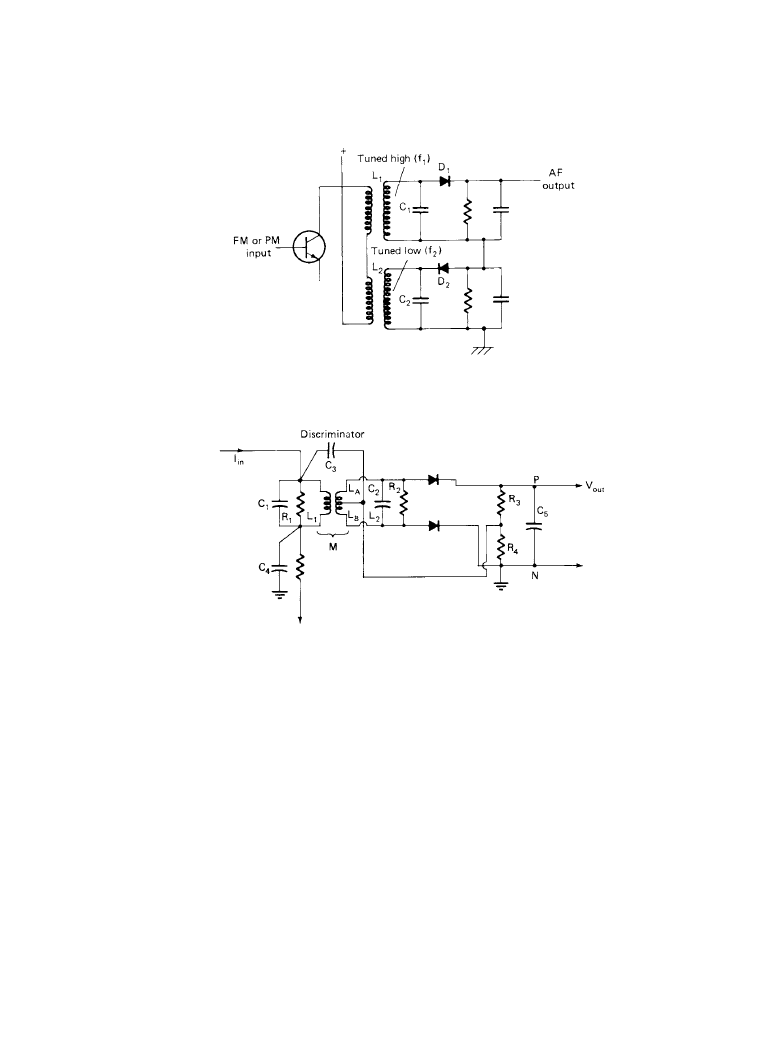
AM and FM Receivers 12-65
demodulators and are then subtracted, eliminating the dc component. Voltage sensitivity is dou-
bled compared to the use of a single circuit. This balanced arrangement also eliminates all even-
order distortion so that the first remaining distortion term is third-order. Figure 12.3.24 shows
one implementation of this scheme, known in the U.S. as the Travis discriminator. Because the
circuit depends on the different amplitude responses of two circuits, it has sometimes been called
an amplitude discriminator.
The Foster-Seeley discriminator, shown in Figure 12.3.25, is a more common approach to FM
demodulation. In this circuit, the voltage across the primary is added to the voltage across each
of the two halves of the tuned secondary. At resonance the secondary voltage is in quadrature
with the primary voltage, but as the frequency changes, so do the phase shifts. The voltages from
the upper and lower halves of the secondary add to the primary voltage in opposition. As the fre-
quency rises, the phase shift increases, and as the frequency falls, it decreases. The opposite
phase additions cause the resulting amplitudes of the upper and lower voltages to differ, produc-
Figure 12.3.24
Schematic diagram of the Travis discriminator. (
From [3]. Used with permission.)
Figure 12.3.25
The Foster-Seeley FM discriminator circuit with tuned primary. (
From [1]. Used
with permission.)
Downloaded from Digital Engineering Library @ McGraw-Hill (www.digitalengineeringlibrary.com)
Copyright © 2004 The McGraw-Hill Companies. All rights reserved.
Any use is subject to the Terms of Use as given at the website.
AM and FM Receivers
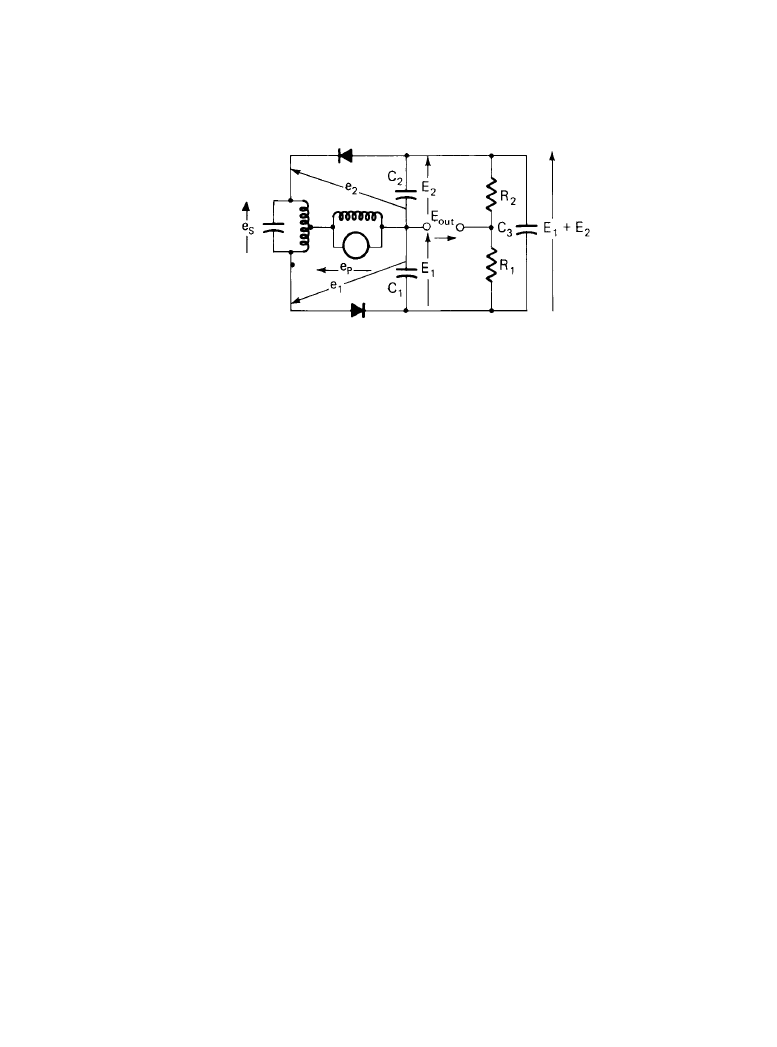
12-66 Radio Receivers
ing the discriminator effect. When the primary circuit is also tuned to the center frequency
(which produces much higher demodulation sensitivity), the phase of the primary voltage also
varies slightly, as does its amplitude. The proper selection of coupling factor is required to pro-
duce optimum sensitivity and linearity of the discriminator. Because of the method of arriving at
the amplitude difference in this demodulator, it is sometimes referred to as a phase discriminator.
The ratio detector is a variant of the phase discriminator that has an inherent degree of AM
suppression. The circuit tolerates less effective limiting in prior circuits and thus can reduce the
cost of the receiver. Figure 12.3.26 shows the basic concept of the ratio detector. It resembles the
Foster-Seeley circuit, except that the diodes are reversed. The combination of R1, R2, and C3 has
a time constant that is long compared to the lowest modulating frequency (on the order of 0.1 s
for audio modulation). The result is that during modulation, the voltage to the (grounded) center
tap across load resistor R2 is (E
1
+ E
2
)/2, and across R1 it is – (E
1
+ E
2
)/2. Following the circuit
from ground through R2 and C2, we see that the voltage at the center tape of the capacitors is
[(E
1
+ E
2
)/2] – E
2
= (E
1
– E
2
)/2, or half of the value of the Foster-Seeley discriminator.
The long time constant associated with C3 reduces the required current from the diodes when
E
1
+ E
2
drops and increases it when E
1
+ E
2
rises. This changes the load on the RF circuit and
causes higher drive when the output falls and lower drive when it rises. This tends to further sta-
bilize the voltage E
1
+ E
2
against incidental AM. The sum voltage can also be used to generate
an AGC signal, so that the prior circuits need not limit. This can be advantageous when a mini-
mum number of circuits is required and the selectivity is distributed.
Amplitude Limiter
Amplitude limiting is essential for FM demodulators using analog circuits. Although solid-state
amplifiers tend to limit when the input signal becomes excessive, limiters that make use of this
characteristic often limit the envelope asymmetrically. For angle demodulation, symmetrical lim-
iting is desirable. AGC circuits, which can keep the signal output constant over wide ranges of
input signals, are unsuitable for limiting because they cannot be designed with sufficiently rapid
response to eliminate the envelope variations encountered in angle modulation interference. One
or more cascaded limiter stages are required for good FM demodulation.
Figure 12.3.26
Schematic diagram of a basic ratio detector circuit. (
From [1]. Used with permis-
sion.)
Downloaded from Digital Engineering Library @ McGraw-Hill (www.digitalengineeringlibrary.com)
Copyright © 2004 The McGraw-Hill Companies. All rights reserved.
Any use is subject to the Terms of Use as given at the website.
AM and FM Receivers
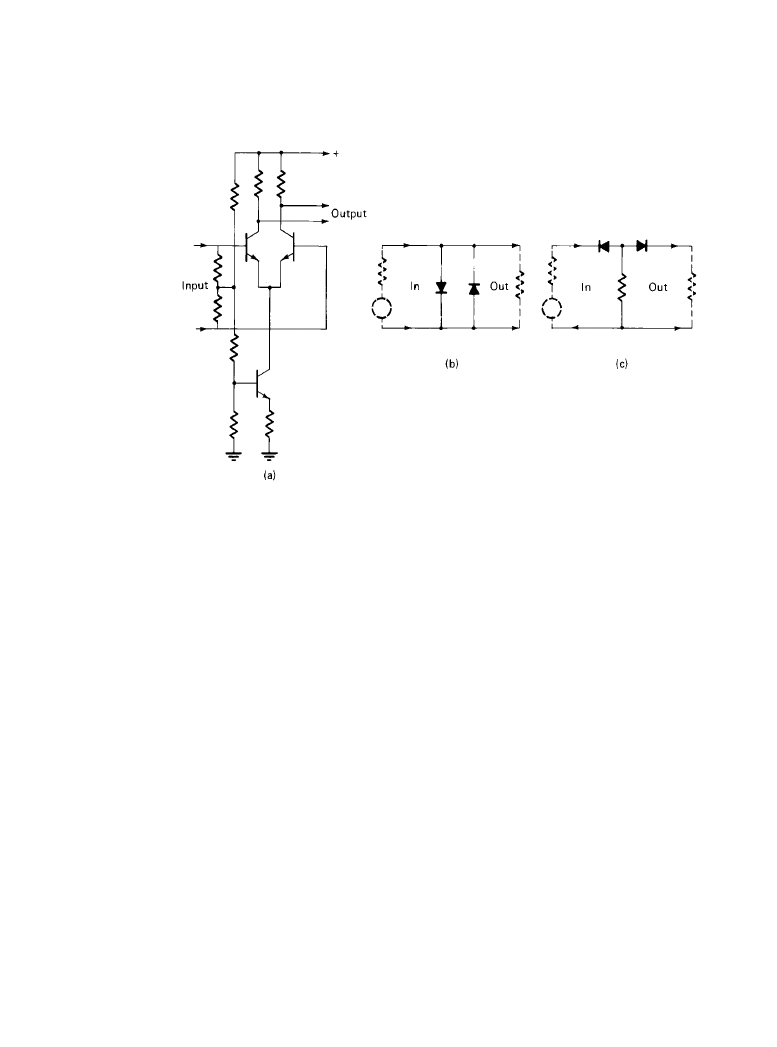
AM and FM Receivers 12-67
Almost any amplifier circuit, when sufficiently driven, provides limiting. However, balanced
limiting circuits produce better results than those that are not balanced. In general, current cutoff
is more effective than current saturation in producing sharp limiting thresholds. Nonetheless,
overdriven amplifiers have been used in many FM systems to provide limiting. If the amplifier is
operated with low supply voltage and near cutoff, it becomes a more effective limiter. The tran-
sistor differential amplifier shown in Figure 12.3.27a is an excellent limiter when the bias of the
emitter load transistor is adjusted to cause cutoff to occur at small base-emitter input levels.
The classic shunt-diode limiter is shown in Figure 12.3.27b. It is important that the off resis-
tance of the diodes be much higher than the driving and load impedances, and the on resistance
be much lower. Figure 12.3.27c shows the classic series diode limiter. In this example the diodes
are normally biased on, so that they permit current flow between the driver and the load. As the
RF input voltage rises, one diode is cut off—and as it falls, the other is cut off. The effectiveness
of limiting is determined by the difference in off and on resistances of the diode, compared to the
driving and load impedances.
Figure 12.3.27
Typical FM limiter circuits: (
a) balanced-transistor amplifier, (b) shunt-diode lim-
iter, (
c) series diode limiter. (From [1]. Used with permission.)
Downloaded from Digital Engineering Library @ McGraw-Hill (www.digitalengineeringlibrary.com)
Copyright © 2004 The McGraw-Hill Companies. All rights reserved.
Any use is subject to the Terms of Use as given at the website.
AM and FM Receivers